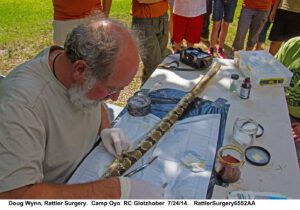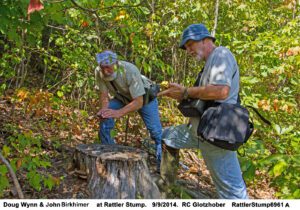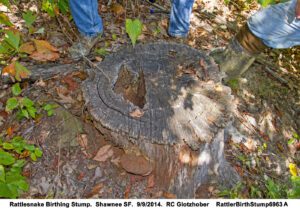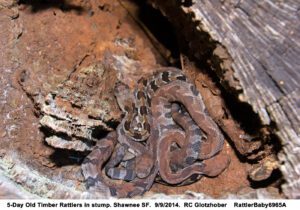On June 27th this year I posted this blog about searching for Timber Rattlesnakes with Doug Wynn. I have been blessed to get into the field two more times with Doug, and each has been a memorable experience. Last week our trip was memorable in a variety of ways–not all of them pleasant.

Earlier this year Doug received a pregnant female rattlesnake that was found along a service road in Shawnee State Forest. Such live snakes are presented to Doug from time to time by people who are familiar with his research and conservation efforts. When this happens, Doug surgically implants a radio transmitter. Afterwards, he holds the snake for about five days, administering antibiotics to make certain the snake is healthy before releasing it. Next, he goes as close as possible to where it was found and releases it. The idea, of course, is to follow it from time to time during the summer to see how far it travels, what habitat it uses, and anything else that can be determined about its natural history.
Since this snake was pregnant, it was of special interest to find out where it went to give birth. I joined Doug on July 24th and we climbed all over the hills of Shawnee. The signal from the females transmitter kept going strong, then weak. Doug told me that sometimes signals will bounce off of hillsides in a valley between the hills, or a ledge or trees might obstruct, temporarily conceal or bounce the signal so that it appears to be coming from a different location. Usually, however, with time, those false signals can be worked out as you cover more ground and get signal directions from multiple locations. After several hours on July 24th–we had to give up. Doug had a commitment for an afternoon demonstration of implanting a transmitter in another snake and did not want to be late.
I traveled down to Shawnee State Forest and joined Doug and his good friend and former co-teacher John Birkhimer on September 9th. They had made another effort the day before at finding the elusive pregnant female rattler. That day had become the fourth failed, fatiguing effort at pinpointing the female. This day, the three of us would try one more time to find the female. The good news was, they had furthered narrowed the search and had a plan of attack. We would park further down the road and head up to the top of a winding ridge line. Following this ridge, we anticipated locating the female a little over the edge near the top of a ten-year-old clear cut.
While the terrain seemed like it would be a fairly easy hike, the ridge top proved to be a dense tangle of greenbrier. If we dropped down to our left, we would lose the telemetry signal behind the hill. If we dropped down to our right, wed enter an even denser tangle of the clear cut. The only reasonable path was to stay on the ridge top. Reasonable? That becomes a relative term. Greenbrier has quarter-inch long, straight thorns that tear at both clothing and skin. Their evergreen, twining stems enable the plant to climb and cling to other vegetation and create tangles that are hard to penetrate unless you are Brer Rabbit! In some places we could carefully step on the thorny branches and push them out of our way with our boots. In other places they twisted high above our heads and we had to try to push them aside and crawl between them. It was not long before each of us had bloody arms.
The good news was, we still had signals from the transmitter inside the female rattler and those signals seemed to be getting stronger. After nearly three hours of bush-wacking we realized we had actually passed by the source of the signal. It was time to retrace our steps and work more slowly and carefully. About 100 yards back, the signal seemed to be just down the hill from us. A later study of the maps would show that in three hours we had covered only about three-quarters of a mile but it had felt like ten! 
We slowly started down the hillside, and as we did the signal became even stronger. We were very close. Then the signal got a little weaker. Was the snake on the other side of a large oak in front of us? No, but perhaps the oak was partially blocking the signal. Then we spotted an old, rotting, cut-off stump nearby. No sign of the snake on or behind that stump. We stood by the stump for a moment, distracted by an interesting large, reddish wasp. [See an upcoming blog on this wasp and its unusual behavior.] Then Doug noticed that the signal was weaker in most directions–but if he held the receiver directly above the rotten stump, it was much, much stronger. The snake had to be inside the rotten stump which we were now surrounding!

The stump had a hole on the downhill side, but we could see nothing inside that hole. There was another, large hole on the top of the stump, going down into its interior. Inside this hole, perhaps down eight inches or so, sat four ten or twelve-inch long baby Timber Rattlesnakes. As we watched, one of them crawled deeper still, joining a fifth baby another six inches deeper into the rotten core of the stump.
As we watched, Doug noted that two of the five babies had molted. Three were sort of a muted, reddish brown color, but the other two had the bright and bold markings of an adult in a pattern of gray, white, black and brown. Doug explained to us that newborn Timber Rattlesnakes make their first molt when about five days old. We were looking at five-day-old baby snakes, which most likely were given birth inside this hollow stump. Rattlesnakes, by the way, are what is known as ovoviviparous–which means they carry the baby snakes inside soft egg sacks inside their body, then give live birth.

What a fantastic finding! To say we were thrilled is to put it mildly. Five days of hard hiking and searching (only two for me) had finally paid off with a valuable observation. We never did see the female, but she must have been deeper yet within the stump based upon the signals from her transmitter. We spent perhaps half an hour watching the snakes (and the wasp) and trying to get photos of them. Photography was challenging trying to get autofocus or even manual focus to work eight inches down into the dark cavity of the stump. Not to mention not wanting to brace our arms on the stump to steady our cameras. Meanwhile, we wondered if the large female might at some point emerge to defend her babies. She never did.
The hike back out was somewhat easier being mostly downhill and following a path we had already partially cleared. But greenbrier tends to spring back quickly and we still struggled to avoid its thorns. Over the two days, John had developed bad blisters on the heel of one foot, which grinded painfully as he stepped downhill. We all were caught more thorns. Somewhere mixed in with the greenbrier was some poison ivy. I managed to spot some of it, and avoid it but obviously there was more that I got into while dodging the greenbrier. The next day, both my arms were covered with poison ivy blisters, which took almost two weeks to heal.
Would I repeat the experience with more bleeding from greenbrier and scratching from poison ivy? You bet! In fact, I’ve been contemplating what I could have done to use my tripod to steady the camera just in case a similar situation presents itself someday. Rattlesnakes, greenbrier, and steep forested hills are all part of the allure of the wild area known as Shawnee State Forest–a real Ohio treasure.
By the way, you will not find the name Greenbrier Ridge on any maps. To protect the snakes, we would not report a precise location. But we all agreed that this particular ridge should have that name, and we will probably use that nomenclature in future discussions, loaded with interesting memories.
Bob Glotzhober
Curator Emeritus of Natural History